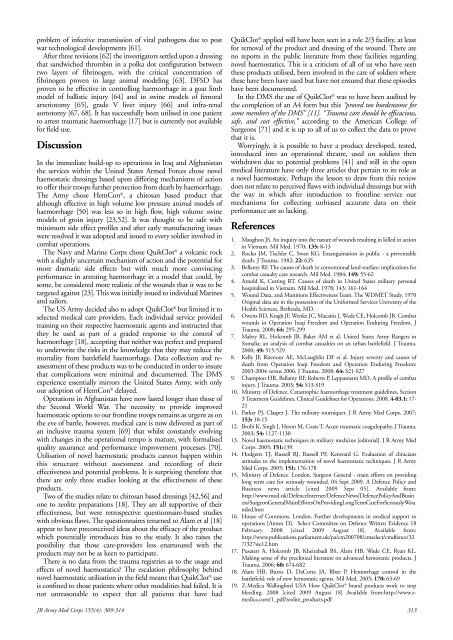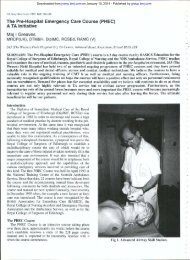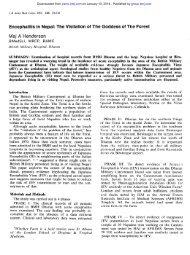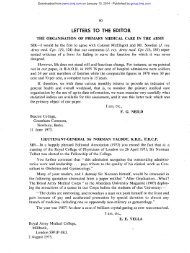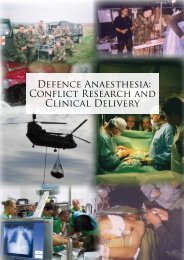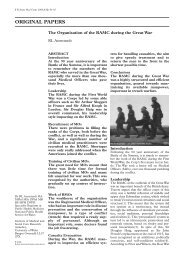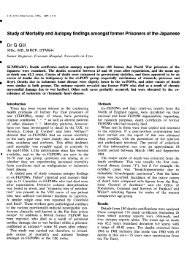Novel Haemostatic Dressings - Journal of the Royal Army Medical ...
Novel Haemostatic Dressings - Journal of the Royal Army Medical ...
Novel Haemostatic Dressings - Journal of the Royal Army Medical ...
Create successful ePaper yourself
Turn your PDF publications into a flip-book with our unique Google optimized e-Paper software.
problem <strong>of</strong> infective transmission <strong>of</strong> viral pathogens due to post<br />
war technological developments [61].<br />
After three revisions [62] <strong>the</strong> investigators settled upon a dressing<br />
that sandwiched thrombin in a polka dot configuration between<br />
two layers <strong>of</strong> fibrinogen, with <strong>the</strong> critical concentration <strong>of</strong><br />
fibrinogen proven in large animal modeling [63]. DFSD has<br />
proven to be effective in controlling haemorrhage in a goat limb<br />
model <strong>of</strong> ballistic injury [64] and in swine models <strong>of</strong> femoral<br />
arteriotomy [65], grade V liver injury [66] and infra-renal<br />
aortotomy [67, 68]. It has successfully been utilised in one patient<br />
to arrest traumatic haemorrhage [17] but is currently not available<br />
for field use.<br />
Discussion<br />
In <strong>the</strong> immediate build-up to operations in Iraq and Afghanistan<br />
<strong>the</strong> services within <strong>the</strong> United States Armed Forces chose novel<br />
haemostatic dressings based upon differing mechanisms <strong>of</strong> action<br />
to <strong>of</strong>fer <strong>the</strong>ir troops fur<strong>the</strong>r protection from death by haemorrhage.<br />
The <strong>Army</strong> chose HemCon ® , a chitosan based product that<br />
although effective in high volume low pressure animal models <strong>of</strong><br />
haemorrhage [50] was less so in high flow, high volume swine<br />
models <strong>of</strong> groin injury [23,52]. It was thought to be safe with<br />
minimum side effect pr<strong>of</strong>iles and after early manufacturing issues<br />
were resolved it was adopted and issued to every soldier involved in<br />
combat operations.<br />
The Navy and Marine Corps chose QuikClot ® a volcanic rock<br />
with a slightly uncertain mechanism <strong>of</strong> action and <strong>the</strong> potential for<br />
more dramatic side effects but with much more convincing<br />
performance in arresting haemorrhage in a model that could, by<br />
some, be considered more realistic <strong>of</strong> <strong>the</strong> wounds that it was to be<br />
targeted against [23]. This was initially issued to individual Marines<br />
and sailors.<br />
The US <strong>Army</strong> decided also to adopt QuikClot ® but limited it to<br />
selected medical care providers. Each individual service provided<br />
training on <strong>the</strong>ir respective haemostatic agents and instructed that<br />
<strong>the</strong>y be used as part <strong>of</strong> a graded response to <strong>the</strong> control <strong>of</strong><br />
haemorrhage [18], accepting that nei<strong>the</strong>r was perfect and prepared<br />
to underwrite <strong>the</strong> risks in <strong>the</strong> knowledge that <strong>the</strong>y may reduce <strong>the</strong><br />
mortality from battlefield haemorrhage. Data collection and reassessment<br />
<strong>of</strong> <strong>the</strong>se products was to be conducted in order to insure<br />
that complications were minimal and documented. The DMS<br />
experience essentially mirrors <strong>the</strong> United States <strong>Army</strong>, with only<br />
our adoption <strong>of</strong> HemCon ® delayed.<br />
Operations in Afghanistan have now lasted longer than those <strong>of</strong><br />
<strong>the</strong> Second World War. The necessity to provide improved<br />
haemostatic options to our frontline troops remains as urgent as on<br />
<strong>the</strong> eve <strong>of</strong> battle, however, medical care is now delivered as part <strong>of</strong><br />
an inclusive trauma system [69] that whilst constantly evolving<br />
with changes in <strong>the</strong> operational tempo is mature, with formalised<br />
quality assurance and performance improvement processes [70].<br />
Utilisation <strong>of</strong> novel haemostatic products cannot happen within<br />
this structure without assessment and recording <strong>of</strong> <strong>the</strong>ir<br />
effectiveness and potential problems. It is surprising <strong>the</strong>refore that<br />
<strong>the</strong>re are only three studies looking at <strong>the</strong> effectiveness <strong>of</strong> <strong>the</strong>se<br />
products.<br />
Two <strong>of</strong> <strong>the</strong> studies relate to chitosan based dressings [42,56] and<br />
one to zeolite preparations [18]. They are all supportive <strong>of</strong> <strong>the</strong>ir<br />
effectiveness, but were retrospective questionnaire-based studies<br />
with obvious flaws. The questionnaires returned to Alam et al [18]<br />
appear to have preconceived ideas about <strong>the</strong> efficacy <strong>of</strong> <strong>the</strong> product<br />
which potentially introduces bias to <strong>the</strong> study. It also raises <strong>the</strong><br />
possibility that those care-providers less enamoured with <strong>the</strong><br />
products may not be as keen to participate.<br />
There is no data from <strong>the</strong> trauma registries as to <strong>the</strong> usage and<br />
effects <strong>of</strong> novel haemostatics? The escalation philosophy behind<br />
novel haemostatic utilisation in <strong>the</strong> field means that QuikClot ® use<br />
is confined to those patients where o<strong>the</strong>r modalities had failed. It is<br />
not unreasonable to expect that all patients that have had<br />
QuikClot ® applied will have been seen in a role 2/3 facility, at least<br />
for removal <strong>of</strong> <strong>the</strong> product and dressing <strong>of</strong> <strong>the</strong> wound. There are<br />
no reports in <strong>the</strong> public literature from <strong>the</strong>se facilities regarding<br />
novel haemostatics. This is a criticism <strong>of</strong> all <strong>of</strong> us who have seen<br />
<strong>the</strong>se products utilised, been involved in <strong>the</strong> care <strong>of</strong> soldiers where<br />
<strong>the</strong>se have been have used but have not ensured that <strong>the</strong>se episodes<br />
have been documented.<br />
In <strong>the</strong> DMS <strong>the</strong> use <strong>of</strong> QuikClot ® was to have been audited by<br />
<strong>the</strong> completion <strong>of</strong> an A4 form but this “proved too burdensome for<br />
some members <strong>of</strong> <strong>the</strong> DMS” [11]. “Trauma care should be efficacious,<br />
safe, and cost effective,” according to <strong>the</strong> American College <strong>of</strong><br />
Surgeons [71] and it is up to all <strong>of</strong> us to collect <strong>the</strong> data to prove<br />
that it is.<br />
Worryingly, it is possible to have a product developed, tested,<br />
introduced into an operational <strong>the</strong>atre, used on soldiers <strong>the</strong>n<br />
withdrawn due to potential problems [41] and still in <strong>the</strong> open<br />
medical literature have only three articles that pertain to its role as<br />
a novel haemostatic. Perhaps <strong>the</strong> lesson to draw from this review<br />
does not relate to perceived flaws with individual dressings but with<br />
<strong>the</strong> way in which after introduction to frontline service our<br />
mechanisms for collecting unbiased accurate data on <strong>the</strong>ir<br />
performance are so lacking.<br />
References<br />
1. Maughon JS. An inquiry into <strong>the</strong> nature <strong>of</strong> wounds resulting in killed in action<br />
in Vietnam. Mil Med. 1970; 135: 8-13<br />
2. Rocko JM, Tischler C, Swan KG. Exsanguination in public - a preventable<br />
death. J Trauma. 1982; 22: 635<br />
3. Bellamy RF. The causes <strong>of</strong> death in conventional land warfare: implications for<br />
combat casualty care research. Mil Med. 1984; 149: 55-62<br />
4. Arnold K, Cutting RT. Causes <strong>of</strong> death in United States military personal<br />
hospitalized in Vietnam. Mil Med. 1978; 143: 161-164<br />
5. Wound Data, and Munitions Effectiveness Team. The WDMET Study. 1970<br />
Original data are in <strong>the</strong> possession <strong>of</strong> <strong>the</strong> Uniformed Services University <strong>of</strong> <strong>the</strong><br />
Health Sciences, Be<strong>the</strong>sda, MD.<br />
6. Owens BD, Kragh JF, Wenke JC, Macaitis J, Wade CE, Holcomb JB. Combat<br />
wounds in Operation Iraqi Freedom and Operation Enduring Freedom. J<br />
Trauma. 2008; 64: 295-299<br />
7. Mabry RL, Holcomb JB, Baker AM et al. United States <strong>Army</strong> Rangers in<br />
Somalia: an analysis <strong>of</strong> combat casualties on an urban battlefield. J Trauma.<br />
2000; 49: 515-529<br />
8. Kelly JF, Ritenour AE, McLaughlin DF et al. Injury severity and causes <strong>of</strong><br />
death from Operation Iraqi Freedom and Operation Enduring Freedom:<br />
2003-2004 versus 2006. J Trauma. 2008; 64: S21-S27<br />
9. Champion HR, Bellamy RF, Roberts P, Leppaniemi MD. A pr<strong>of</strong>ile <strong>of</strong> combat<br />
injury. J Trauma. 2003; 54: S13-S19<br />
10. Ministry <strong>of</strong> Defence. Catastrophic haemorrhage treatment guidelines. Section<br />
3 Treatment Guidelines. Clinical Guidelines for Operations. 2008. 4-03.1: 17-<br />
21<br />
11. Parker PJ, Clasper J. The military tourniquet. J R <strong>Army</strong> Med Corps. 2007;<br />
153: 10-15<br />
12. Brohi K, Singh J, Heron M, Coats T. Acute traumatic coagulopathy. J Trauma.<br />
2003; 54: 1127-1130<br />
13. <strong>Novel</strong> haemostatic techniques in military medicine [editorial]. J R <strong>Army</strong> Med<br />
Corps. 2005; 151:139.<br />
14. Hodgetts TJ, Russell RJ, Russell PF, Kenward G. Evaluation <strong>of</strong> clinicians<br />
attitudes to <strong>the</strong> implementation <strong>of</strong> novel haemostatic techniques. J R <strong>Army</strong><br />
Med Corps. 2005; 151: 176-178<br />
15. Ministry <strong>of</strong> Defence. London. Surgeon General - main efforts on providing<br />
long term care for seriously wounded. 04 Sept 2009. A Defence Policy and<br />
Business news article [cited 2009 Sept 05]. Available from:<br />
http://www.mod.uk/DefenceInternet/DefenceNews/DefencePolicyAndBusin<br />
ess/SurgeonGeneralMainEffortsOnProvidingLongTermCareForSeriouslyWou<br />
nded.htm<br />
16. House <strong>of</strong> Commons. London. Fur<strong>the</strong>r developments in medical support to<br />
operations [Annex D]. Select Committee on Defence Written Evidence 18<br />
February 2008 [cited 2009 August 18]. Available from:<br />
http://www.publications.parliament.uk/pa/cm200708/cmselect/cmdfence/32<br />
7/327we12.htm<br />
17. Pusateri A, Holcomb JB, Kheirabadi BS, Alam HB, Wade CE, Ryan KL.<br />
Making sense <strong>of</strong> <strong>the</strong> preclinical literature on advanced hemostatic products. J<br />
Trauma. 2006; 60: 674-682<br />
18. Alam HB, Burris D, DaCorta JA, Rhee P. Hemorrhage control in <strong>the</strong><br />
battlefield: role <strong>of</strong> new hemostatic agents. Mil Med. 2005; 170: 63-69<br />
19. Z-Medica Wallingford USA How QuikClot ® brand products work to stop<br />
bleeding. 2008 [cited 2009 August 18] Available from:http://www.zmedica.com/1_pdf/zeolite_products.pdf<br />
JR <strong>Army</strong> Med Corps 155(4): 309-314 313


